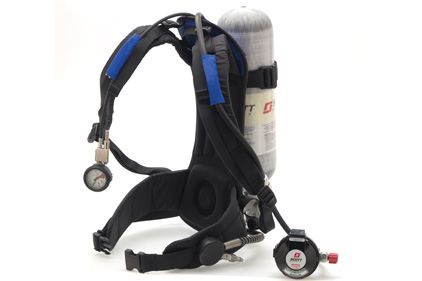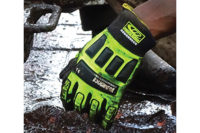Know your limits
Counter chlorine with the right respiratory protection

Exposure to chlorine — which may occur when changing chlorine tanks or working in chlorine rooms, among other activities — can cause a host of respiratory problems1 if inhaled. Mild to moderate exposure may produce eye, nose and throat irritation, coughing spasms, a restriction of the upper airway and an accumulation of fluid in the lungs (pulmonary edema) that leads to a choking sensation. More severe exposure can narrow the upper airway so significantly that it causes sudden death. Respiratory failure accounts for the majority of deaths caused by chlorine exposure.2 Choosing proper respiratory protection and conducting a thorough hazard assessment are critical to ensuring worker safety.
Respirator selection must be done by a knowledgeable person. Respirator use is only one part of the respiratory protection program required by OSHA’s Respiratory Protection Standard [29 CFR 1910.134], which also includes regular training, fit-testing, fit-checking, maintenance and cleaning, and periodic environmental monitoring, among other elements.3
Lots of options
Respiratory protection devices for chlorine and chlorine dioxide exposures are similar, and range from chemical cartridge respirators to supplied air respirators (SAR) operating in continuous-flow mode to the kind of self-contained breathing apparatus (SCBA) used in emergency situations. All respirators selected must be, at minimum, approved by NIOSH under the provisions of 42 CFR 84.4
According to OSHA, respirators may be used before engineering controls have been installed; during work operations such as maintenance or repair activities that involve unknown exposures; during operations that require entry into tanks or closed vessels and during emergencies.
Choosing effective respiratory protection requires knowing the Maximum Use Concentration (MUC) levels to which workers may potentially be exposed. Routine exposures call for a different type of protective device than that used with an uncontrolled release, where the concentration may be unknown. It is also important that the wearer be trained and fitted for the respirator.
Start with exposure limits
Chlorine (Cl2):
L NIOSH Recommended Exposure Limit (REL: C 0.5 parts per million (pm) (1.45 mg/m3) [15-minute].
L OSHA Permissible Exposure Limit (PEL): †: C 1 ppm (3 mg/m3)5.
Chlorine Dioxide (ClO2):
L NIOSH REL: TWA 0.1 ppm (0.3 mg/m3) ST 0.3 ppm (0.9 mg/m3)6.
L OSHA PEL: †: TWA 0.1 ppm (0.3 mg/m3)5.
Detection technologies
Chlorine and chlorine dioxide are detected using the same technologies: Electrochemical (E-Chem) Sensors and Photo Ionization Detection technology (PID).
E-Chem gas sensors measure the concentration of a target gas by oxidizing or reducing the target gas at an electrode and measuring the resulting current.
E-Chem monitors have advantages: they’re available in small sizes, require less power than other types and can target specific gases. They may fail, however, in extreme situations, where gas is present in high concentrations. Furthermore, they are not designed for process control, and some are consumptive. Sensors may give false readings due to drift; choosing a more stable sensor results in less drift and increased accuracy.
PID sensors measure volatile organic compounds and other gases, producing instantaneous readings. Photo ionization occurs when an atom or molecule absorbs light of sufficient energy to cause an electron to leave and create a positive ion. The accuracy of the PID may be affected by high levels of humidity or the presence of a compound like methane in high concentrations.
Fixed or portable?
There are two main types of gas detection devices: fixed and portable. Fixed devices allow for continuous monitoring and often contain better sensoring technology. They may connect to a computer control system that will enable the activation of alarms or fans when a certain level of gas is detected. Portable devices are ideal for personal protection and for remote areas.
The area of coverage will depend both on the physical properties of the gas (density, temperature, reactivity) and environmental conditions (temperature, wind, rain/fog).
For Cl2 and ClO2 the detection devices will measure gas in parts per million (PPM) and can be correlated to the following exposure limits enabling the user to select the proper respiratory protection based on assessment.
L PELs
L RELs
L Time Weighted Average (TWA)
L Short Term Exposure Limit (STEL)
L Immediately Dangerous To Life & Health (IDLH)
L Threshold Limit Values (TLV’s)
L Maximum Use Concentration (MUC)
The APFs of respirator recommendations
Assigned Protection Factors (APFs) are defined in OSHA 1910.134 Table 1. Respirators are designated an APF based on the protection they will provide when a trained user is properly wearing and using the device. The APF, along with the defined exposure level (e.g. PEL or REL), will determine the atmospheric levels of hazardous gas in which a respirator can be worn.
A full face air purifying respirator (APR) has an APF of 50. This APR — equipped with a chemical cartridge providing protection against the hazard of concern — can provide protection for the wearer up to 50 times the REL or as high as the defined IDLH, whichever is lower. Chlorine, for example, has an REL of 0.5ppm. Therefore, the full face APR described above will provide protection up to 25ppm, unless the IDLH is lower. The IDLH of ClO2 is 10ppm, for which a full face APR is insufficient protection. Any exposure greater than 10ppm of ClO2 would require an air supplied respirator operated in positive pressure mode.
In emergency situations, where the concentrations of gas are unknown or where IDLH conditions may be present, NIOSH calls for a respirator with a 10,000 APF respirator. This solution could be any combinationSAR or any SCBA operated in a positive pressure mode.
In the escape category, NIOSH requires an air-purifying, full-facepiece respirator (gas mask) with an APF of 50, a chin-style, front- or back-mounted canister providing protection against the compound of concern, or any appropriate escape-type, self-contained breathing apparatus. There are open circuit and closed circuit, air-supplied emergency escape breathing devices (EEBD) available. EEBDs are, relatively small, lightweight solutions with specific duration of escape time from toxic, IDLH environments (see manufacturer specifications).
Respirator features to consider
Beyond specific exposures, careful consideration of other factors will help determine the best type of respirator to use in a given situation. Some respirators are better suited for longer duration protection. Some can be used with various lengths of air hose, to give the user a greater range of movement.
Certain supplied-air respirators have automatic, hands-free transfer capabilities, causing the air source to be instantly switched to a portable air cylinder if the continuous air supply is interrupted. Supplied air respirators should also be comfortable to wear. Respirators used in confined spaces should have a profile that allows for ease of entry into or escape from confined spaces.
For situations where person-to-person communication is important, respirators with two-way radio interface or voice projection devices are available.
FOOTNOTES
1 Contact with the skin or eyes is also hazardous, but is beyond the scope of this article.
2 NIOSH Emergency Response Safety and Health Database www.cdc.gov/niosh/ershdb/EmergencyResponseCard_29750024.html
3 For details on the 29 CFR 1910.134, see the NIOSH pocket guide to chemical hazards: www.cdc.gov/niosh/npg/pgintrod.html#mustread
4 DHHS (NIOSH) Publication #96-101: Guide to the Selection and Use of Particulate Respirators www.cdc.gov/niosh/docs/96-101/
5 NIOSH Pocket Guide to Chemical Hazards/Chlorine www.cdc.gov/niosh/npg/npgd0115.html
6 NIOSH Pocket Guide to Chemical Hazards/Chlorine dioxide www.cdc.gov/niosh/npg/npgd0116.html
Looking for a reprint of this article?
From high-res PDFs to custom plaques, order your copy today!





